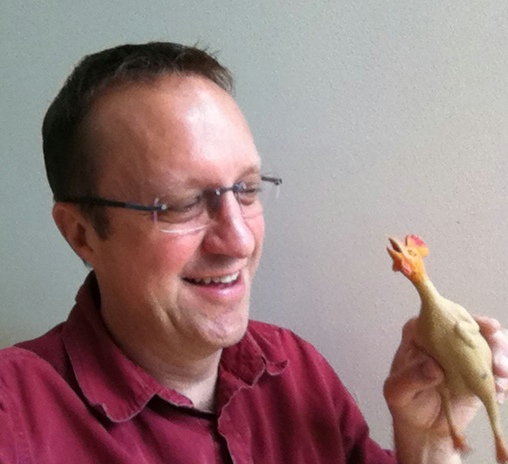Jul 31, 2013

Next time I’m planning an idea-generating session, I’ll consider suggesting that we invite a few new people to the group who can offer a novel take. Maybe I’ll even throw a rubber chicken into the circle when things are running along a predictable path! ~ Michael Culliton
For years I have used “brainstorming” to help groups generate creative responses to important and challenging situations. Recently, I’ve run across several things that have led me to realize that if I really want to help groups cultivate and amplify creativity, then I need to do some things differently.
The journey began with reading James Zull’s The Art of Changing the Brain as preparation for Dr. Jane Vella’s plenary session, “The Biology of Learning,” at the October 2013 International Dialogue Education Institute. This has heightened my curiosity about learning, creativity and the brain and led me to, among other things, a fascinating interview with Rex Jung, a professor of neurosurgery and a clinical neuropsychologist talking about creativity and the everyday brain.
It was in the interview with Dr. Jung that I heard the bad news: my beloved brainstorming was not a healthy host for creativity. The studies supporting this conclusion are presented in a New Yorker article by Jonah Lehrer, “Groupthink: the brainstorming myth.” (If you are interested in a thorough and nuanced explanation of the research mentioned below, I highly recommend the article.)
Based on the research presented in the article, here are five things I plan to do differently.
- STOP using the term “brainstorming.” As far back as 1958, a study at Yale University showed that the process doesn’t yield the best results within a group. So, I think it’s time to give it up. I’m not sure what to call the revised process of creative idea generation just yet (any ideas?).
- Ask people to engage in “solo” idea-generation first. Subsequent research at Northwestern University confirmed the Yale study and also showed that a group produces a greater number and better quality of ideas when people generate a solo list of ideas first and then bring them to the group. (Sorry fellow extroverts!)
- When the solo ideas are brought to large group, introduce a “debate condition.” Studies done in 2003 at Berkeley found that ideas and actions are more effective when they are vetted via a process that allows for questioning and challenge. (Farewell my sweet brainstorming guideline of “No judging, analyzing, or evaluating of ideas!”) Given the principle of “safety,” as a Dialogue Education practitioner I’ll need to experiment with structures that allow ideas to be vetted while honoring this important principle.
- In group idea-generating conversations, experiment with ways to interject “errant responses” that have the potential to interrupt predictability and foster “aha’s.” The same Berkeley researcher mentioned above found that “unfamiliar perspectives,” as well as “unexpected” – even wacky – responses, can help groups think their way off of well-worn paths. Next time I’m planning an idea-generating session, I’ll consider suggesting that we invite a few new people to the group who can offer a novel take. Maybe I’ll even throw a rubber chicken into the circle when things are running along a predictable path!
- Structure meeting and break-times in ways that foster more mixing and happenstance. Recent studies at Harvard University suggest that physical proximity and spontaneous interactions foster creativity. This has led me to wonder how I as a Dialogue Education practitioner can better structure meeting and break-time environments to increase the opportunity for people to interact with a greater number and variety of people. For starters, in designing meeting processes, perhaps I’ll make greater use of tasks that invite people to share “cocktail party style” or “speed-dating fashion.” Maybe I’ll put the beverages at one end of the room and the snacks at the other.
I’m looking forward to playing with these changes in the idea-generation process and to discovering how these revised practices help me and the groups of which I am a part to be even more creative and productive.
What ideas come to mind for you?
What might a Dialogue Education-based idea-generation process, one that puts the research outlined above into practice, look like?
How might a Dialogue Educator introduce such a practice to a group or in meeting?
*****
Michael Culliton, GLP Partner, is co-facilitating a session entitled Educational Jujitsu for the 21st Century: Applying User Research and Design in Learning at the Learning & Change International Dialogue Education Institute, Oct 24-27, 2013 in Baltimore, MD, USA, where he's also offering one-on-one private consultations.
You can also work with Michael is an upcoming workshop: Learning to Listen, Learning to Teach | October 1-4, 2013 | San Diego, California



